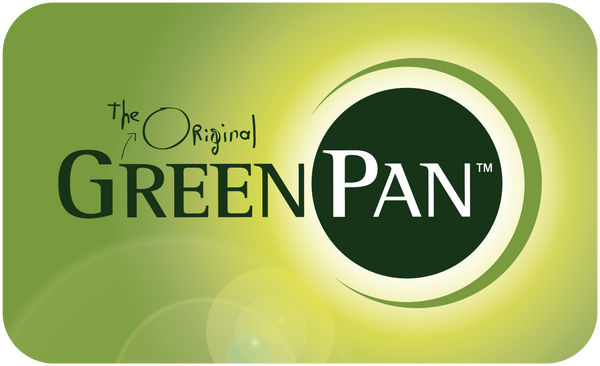Frequently Asked Questions (FAQ)
We love to let everyone know about healthy ceramic nonstick. Here's a quick rundown of some fast facts, the most common questions, and some things that are just good to know.
CERAMIC NON-STICK

What is Thermolon™?
Thermolon™ is the world's first and best ceramic nonstick coating. All GreenPan uses this revolutionary coating. We've created seven generations of Thermolon™. Each is manufactured without forever chemicals and plastics like PFAS and PFOA, and it does not contain any lead or cadmium. It starts with silicon (not to be confused with silicone), which is derived from sand, and is transformed into a sprayable solution, then cured onto the pan in an oven. The curing phase for our pans releases 60% less CO2 than the curing phase for traditional nonstick pans.
How safe is Thermolon™?
The absence of forever chemicals in our pans means they won't release toxic fumes, even if you accidentally overheat your pan. Thermolon™ can withstand temperatures up to 850°F/450°C, something that would not be safe to do with a traditional nonstick frypan. Thermolon™ has been certified by third party testing labs as conforming to international regular food contact standards set by the USFDA (USA Food & Drug Administration) and the German LFGB. Plus, the coating has been certified by the Swiss government and KTR (authoritative test institute certified by Korea Laboratory Accreditation) as conforming to their standards. We are proud to say that GreenPan was the first ceramic nonstick frypan on the market ever. As the innovators, we continue to create dynamic cookware for our consumers all over the world.
How is your ceramic nonstick coating made?
It starts with a sand derivative, which we turn into a solution and spray onto the pan without the need for plastics, glues, and additives. We've cut out the toxins—PFAS, PFOA, lead, and cadmium—so you can cook without worry.
Is your coating PTFE?
No. We don't need plastic. Our Thermolon™ coating starts with sand.
Does Thermolon™ heat faster than other coatings?
Thermolon™ ceramic nonstick is a better heat conductor than traditional nonstick coatings.We recommend that you cook on a lower heat setting than you would do with a traditional nonstick pan. This will prevent your food from burning.
ENVIRONMENT
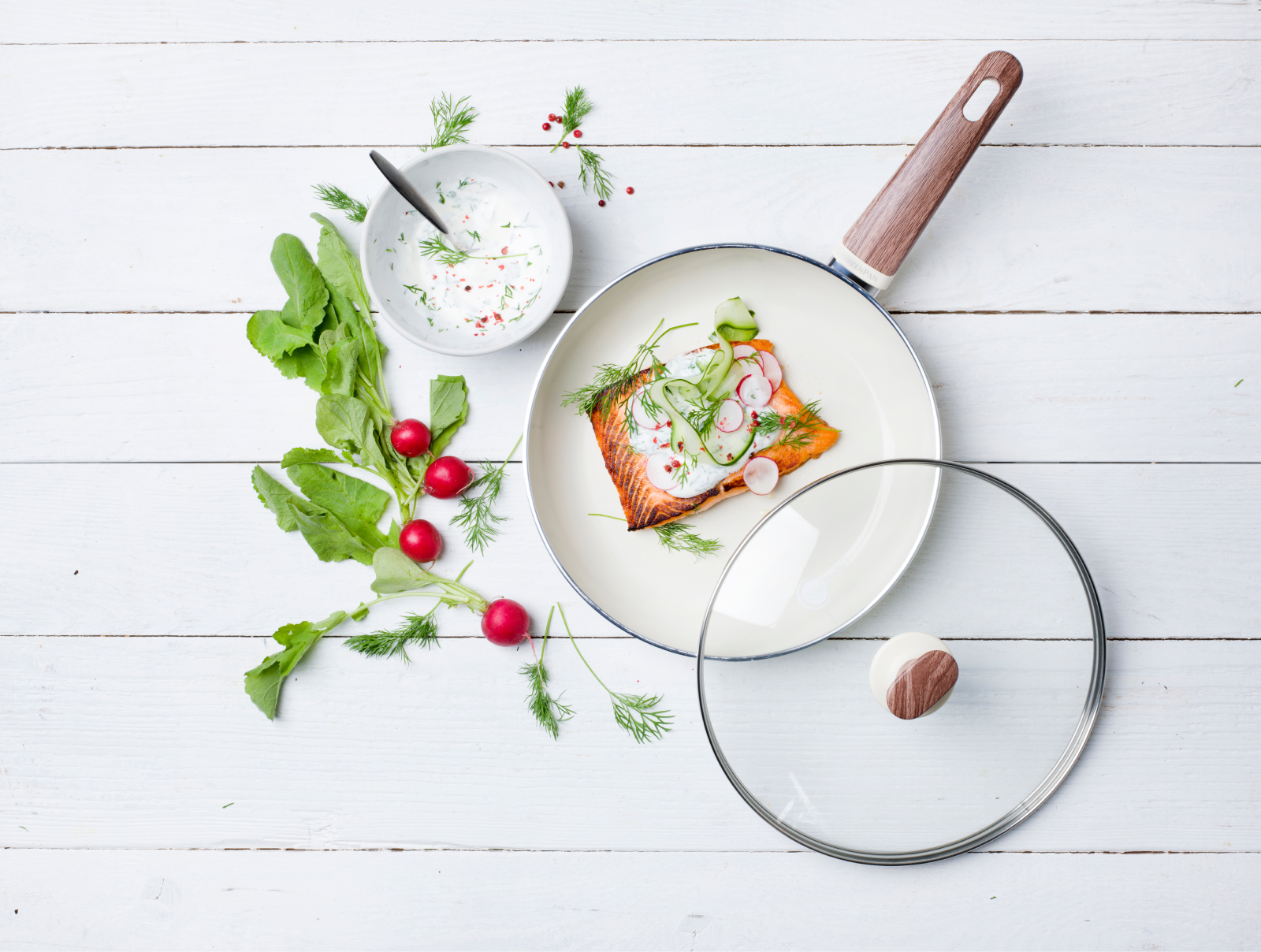
Are your pans really green?
Our pans are made from recycled aluminum and our coating is free of PFAS, PFOA, lead, and cadmium, so you can breathe easily. The curing process for our coating also creates 60% less CO2 than the curing phase for traditional nonstick coatings. The factory gets 30% of its power from the solar panels on the roof and it also has its own wastewater treatment plant to keep our water clean.
Are your pans safe for pets?
Yes. Our healthy ceramic nonstick coating won't release toxic fumes like traditional coatings. Your pets, especially your feathery friends, can watch you cook without worry.
What are these pans made of?
That depends on the collection. GreenPan uses a wide range of materials, including hard anodized aluminum and 3-ply stainless steel. Each of our product pages will detail the pan's construction.
Where are GreenPan products made?
All our products are manufactured in a factory we own outside of Hong Kong in China. Unlike most cookware companies, we own our factory, and we carefully control the process. We've won numerous awards for our environmental safety, our worker satisfaction, and our overall standards. Our factory has its own wastewater treatment plant and 30% of our factory's energy comes from solar panels on the roof. We also have our own in house research and development team working towards the next advancements in healthier and better cooking.
QUICK CARE
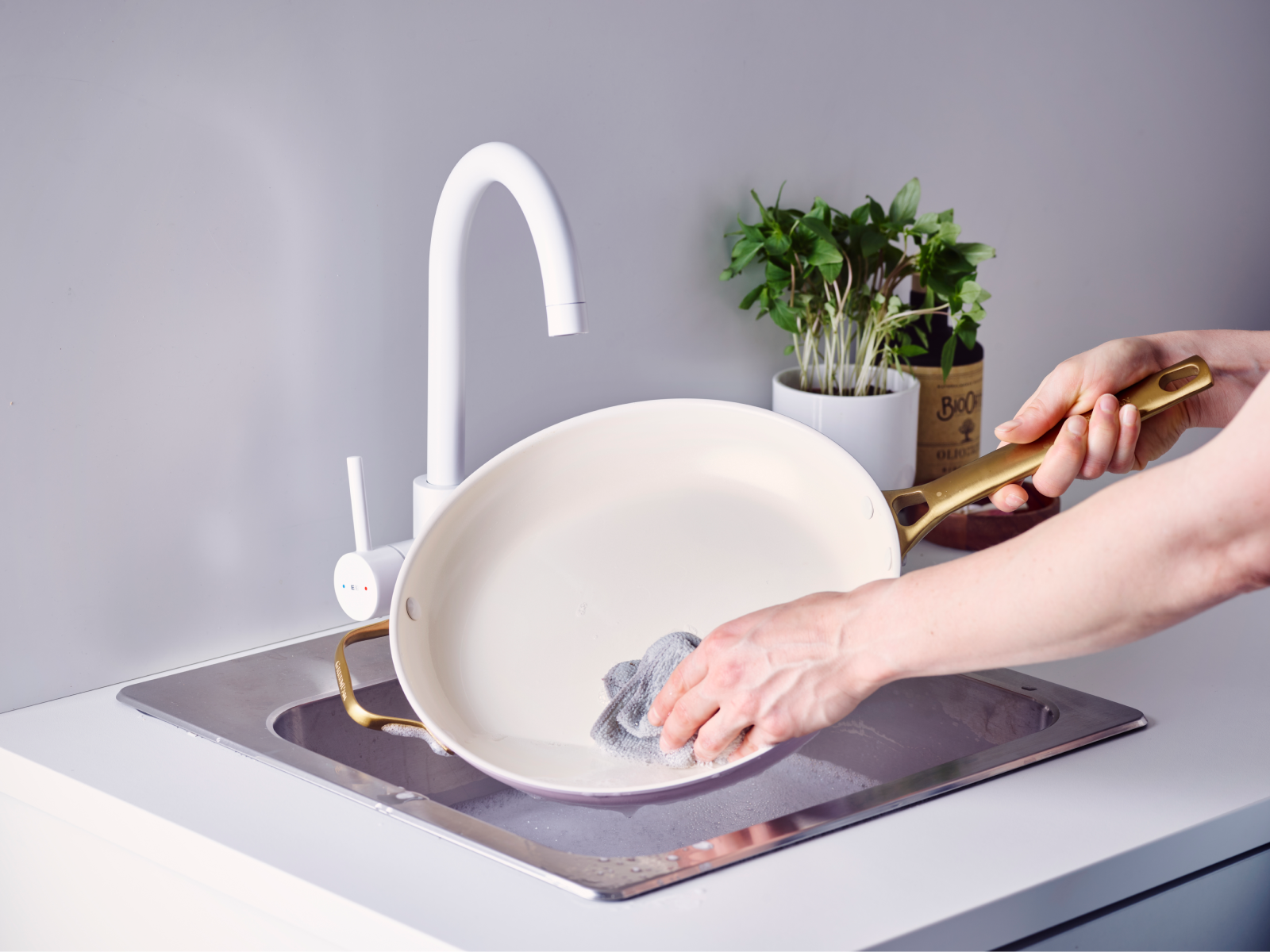
How should I care for my cookware?
To maximize performance use low to medium heat, silicone & wood utensils, and oil or butter. To clean, use a soft sponge with warm, soapy water. Let it cool before washing and store safely.
Can I use metal utensils?
While our coating is tough enough for metal utensils, nylon, bamboo, silicone, and wood utensils will preserve your pan's coating and keep it like new longer.
Are your pans dishwasher safe?
Most collections are, but hand washing is recommended to help your coating last longer. Check packaging or your collection's page for care recommendations.
My pan's surface is scratched, is that a problem?
Scratches, dents, or pits in the coating won't affect the safety or performance of your pan.
How can I deep clean my pan?
For the interior: Fill the pan halfway with water and bring it to a near boil for about 2 minutes. Pour out the water and place the pan on a sturdy surface such as a wooden cutting board. Carefully use a restoring sponge (melamine) on the warm surface, this should do the trick. For the exterior: Mix baking soda with a little water to make a paste. Rub the paste on the stains with a dishcloth or soft-bristled cleaning brush and rinse with white vinegar.
USING OILS
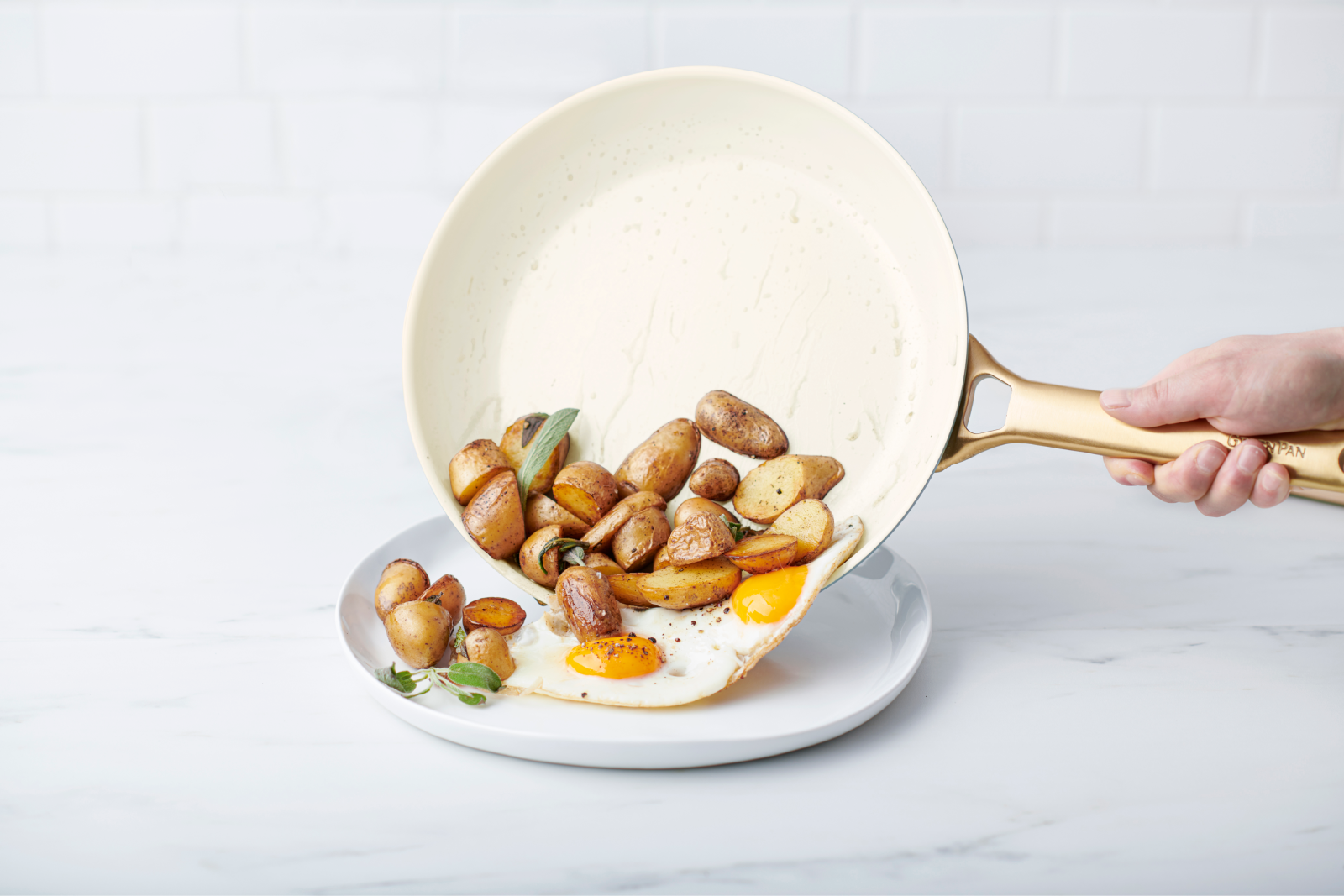
Should I use oils?
Definitely. It tastes better, after all. It also helps distribute heat. But remember—some fats burn at lower temps and burnt on oils make a pan sticky. Technically, you could fry without oil, but we don't recommend it. For high-heat frying, we recommend oils with a high smoke point (eg peanut oil, avocado oil, grapeseed oil, etc). Avoid spray oils, though—they burn quickly and contain a propellant that can damage nonstick coatings. We recommend cooking at a low to medium temp, that way you can avoid burning oils and creating a sticky pan.
What type of oil should I use?
Oils with high smoke points are best. What are those? Avocado oil, canola oil, and grapeseed oils are great examples. EVOO is quick to burn and is not recommended. We recommend watching the heat with oils. Burned oils can create a layer of sticky carbonization on your pan, resulting in the loss of nonstick performance. For information on carbonization, please refer to our Care & Use page. We recommend avoiding sprayoils, including aerosols, mist, and pump sprays. Small spray droplets will heat up very rapidly and carbonize easily on the nonstick surface, and many contain propellants that will damage your pan's nonstick coating. This will leave a layer on the coating and will affect the nonstick performance of the pan.
What do I do with burnt on oils?
If your pan gets a little too hot your oil can burn, which creates sticky spots on your pan. But don't worry, you can get rid of them with a melamine sponge and a bit of water. To avoid burning oils altogether, you should cook on low to medium heat and use an oil with a high smoke point like avocado oil, canola oil, or grapeseed oil.
COOKING WITH GREENPAN
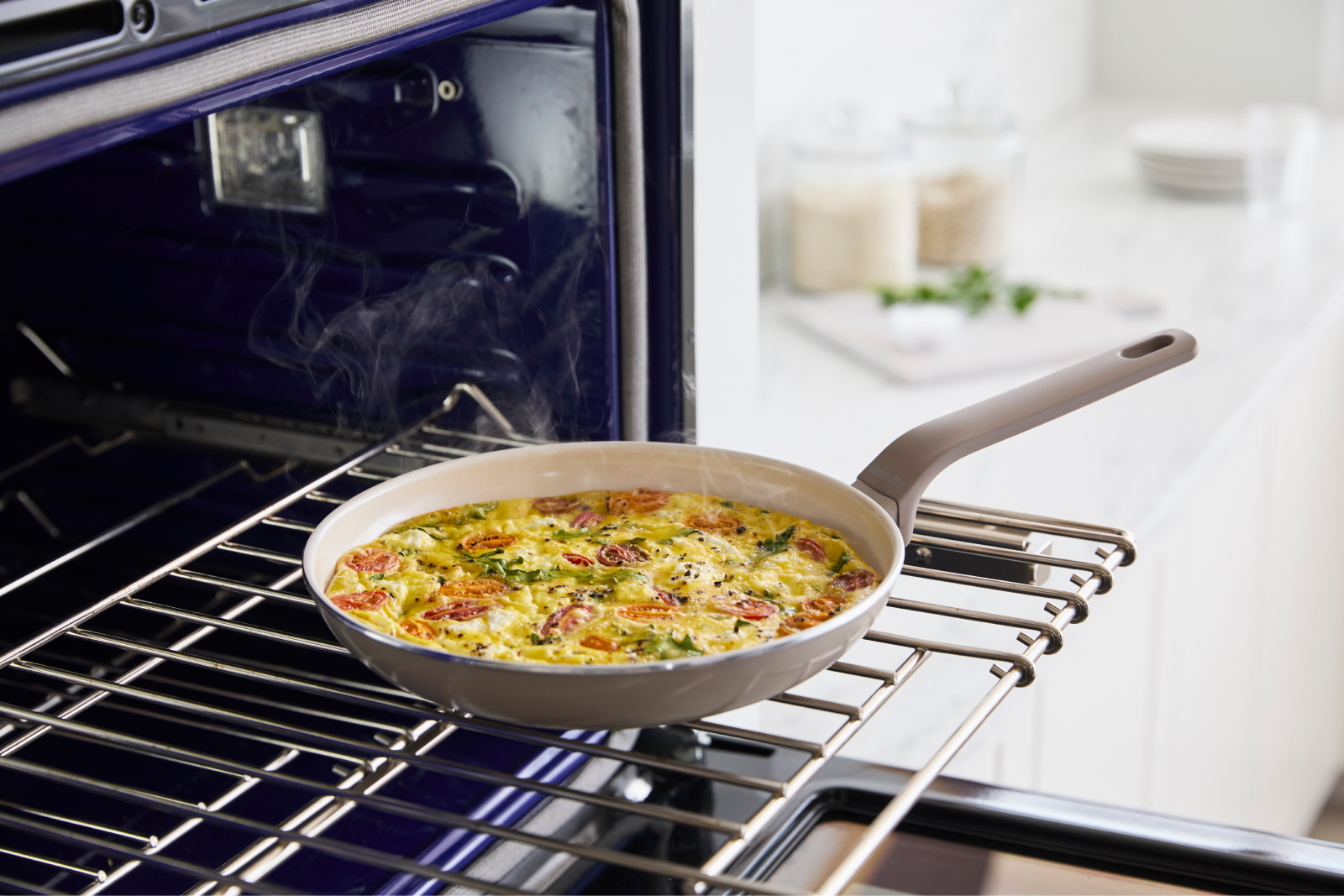
What stovetops can I use my pans on?
Many of our collections are induction compatible. All stainless steel collections are, as well as any collection with our Magneto induction base, which is specially designed for optimized performance on all stovetops. Check our product pages from specific product features and compatibilities.
Is GreenPan induction compatible?
Many of our collections are induction compatible. All stainless steel collections are, as well as any collection with our Magneto induction base, which is specially designed for optimized performance on all stovetops. Check our product pages from specific product features and compatibilities.
Can I put my pan in the oven?
Yes, ceramic nonstick cookware is oven safe. For specific temperature restrictions please refer to your packaging or your collection's page. If you are unsure, please contact us.
